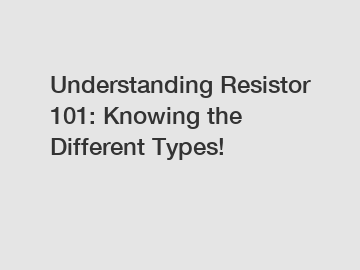Understanding Resistor 101: Knowing the Different Types!
Understanding Resistor 101: Knowing the Different Types!
Have you ever looked at an electronic circuit and wondered what those tiny, colorful components do? If so, you're not alone. Today, we are going to discuss an essential component called a resistor. Resistor plays a crucial role in the world of electronics, regulating voltage and current in circuits to ensure they work correctly. In this article, we will dive deeper into the topic and explore the various types of resistors you may come across.
Resistors are passive two-terminal components that resist the flow of electric current. They are typically made from carbon, metal, or metal oxide, exhibiting a range of resistance values. These resistance values are measured in ohms (Ω), with higher ohm values indicating larger resistance. By introducing resistance, resistors help control the flow of electricity, limiting current to protect sensitive components and ensuring circuits operate within their design parameters.

Now that we understand the basic working principle of resistors let's explore some common types you may encounter.
1. Carbon Composition Resistors:
These resistors are constructed by blending carbon particles with a binder material, forming a solid cylindrical shape. Carbon composition resistors are known for their stability and wide range of resistance values. They are suitable for general-purpose applications and are often used in audio systems due to their low noise characteristics.
2. Film Resistors:
Film resistors are created by depositing a thin resistive film onto a ceramic or fiberglass substrate. They are available in two main types: carbon film resistors and metal film resistors. Carbon film resistors are affordable and widely used in various everyday applications. Metal film resistors, on the other hand, offer better precision, stability, and lower noise levels compared to carbon film resistors. Both types find applications in audio, automotive, power supplies, and many other electronic devices.
3. Wirewound Resistors:
Wirewound resistors are constructed by winding a resistance wire around an insulating ceramic core. These resistors can handle high power dissipation and have low temperature coefficients, making them suitable for high precision and high-power applications. Wirewound resistors often find usage in power supplies, amplifiers, and industrial equipment.
4. Variable Resistors:
Variable resistors, also known as potentiometers or rheostats, allow users to change their resistance value manually. These resistors have three terminals, with the third terminal acting as a wiper. By adjusting the wiper's position, the resistance can be increased or decreased. Variable resistors find extensive use in audio equipment, lighting control, and tuning circuits.
5. Surface Mount Resistors:
Surface mount resistors, or SMD resistors, are relatively newer types of resistors designed to be mounted directly onto circuit boards. They are smaller and more compact compared to traditional through-hole resistors, making them suitable for space-constrained applications. SMD resistors come in various packages, such as 0201, 0402, 0603, and 0805, each denoting their size in millimeters. They are widely used in modern electronics, including smartphones, tablets, and IoT devices.
It is crucial to understand the different types of resistors and their applications to choose the right one for your circuit design. Each type has its own advantages and disadvantages, and selecting the appropriate resistor ensures optimal circuit performance.
In conclusion, resistors are vital components in the world of electronics, regulating the flow of electric current and protecting delicate circuit elements. We explored five common types of resistors, including carbon composition, film, wirewound, variable, and surface mount resistors. Each type offers specific benefits and applications, making it essential to familiarize yourself with their characteristics. So, next time you see those tiny, colorful components on a circuit board, you'll know just how important they are in the grand scheme of things.
Remember, learning about resistors is just the beginning of your electronic adventure. Stay curious, keep exploring, and the world of electronics will continue to unfold before your eyes!
(Note: This article is a general overview and not an exhaustive guide on resistors. Professional advice should be sought for specific applications or further technical details.).
Contact us to discuss your requirements of Metal Oxide Film Resistor Supplie, film type resistor, Metal Oxide Film Resistor Supplie. Our experienced sales team can help you identify the options that best suit your needs.


